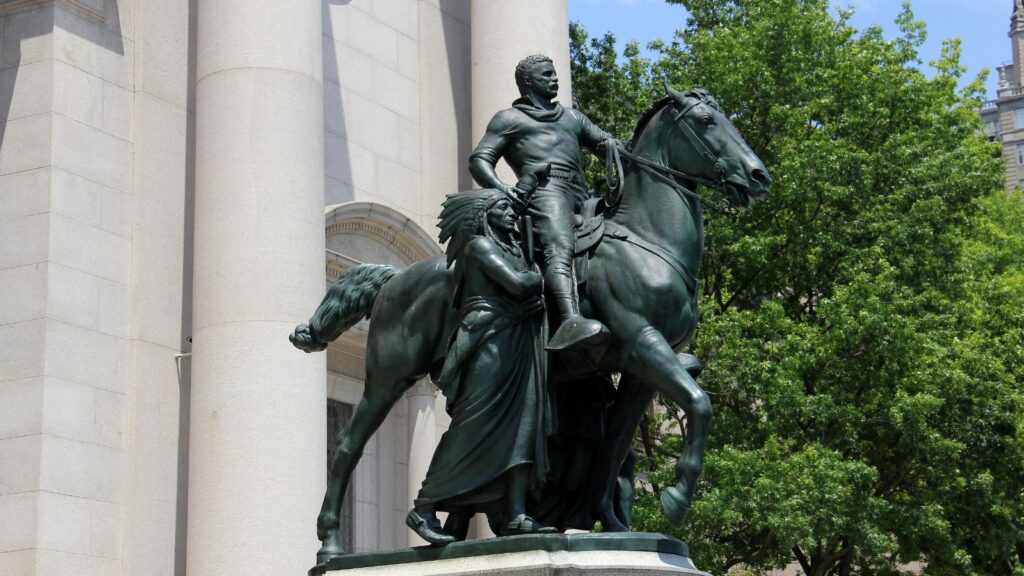Statues commemorating historical figures often celebrate their political, cultural, or artistic achievements. However, in recent years, particularly following the 2020 murder of George Floyd, many statues in the U.S. have been reexamined and ultimately removed due to the problematic legacies they represent, particularly in the context of racial injustice. This article explores 13 such statues that were taken down because of what they symbolized.
Statue of Robert E. Lee, Charlottesville, Virginia

This bronze statue of Robert E. Lee on his horse in Charlottesville was built in 1924 and removed almost a century later. The city council voted in favor of dismantling the monument of Lee, a Confederate general who fought to expand slavery, later leading to a deadly far-right rally. As the Guardian reported, it was removed in June 2021 and melted down with the statue’s brass to “be used for a public art installation in [the] Virginia city.”
Jefferson Davis Memorial, Richmond, Virginia

Jefferson Davis was the president of the breakaway Confederate State of America, and a memorial was installed in his memory in 1907 in Virginia. Protests following the murder of George Floyd saw the statue torn down in June 2020 because of Davis’s role as a white supremacist leader. Axios reports that the statue was later displayed in the Valentine Museum “lying on its back and splattered in paint” from the protest.
Christopher Columbus Statue, North End, Boston, Massachusetts

Boston 25 News reported that “to many people, Christopher Columbus represents slavery and the mass genocide of Indigenous people.” The Italian explorer led the way for European colonization of the Americas, and a marble statue was dedicated to him in Boston in 1979. The statue was beheaded by protestors in the wake of George Floyd’s murder and later removed.
Statue of Edward Carmack, Nashville, Tennessee

Edward W. Carmack was a Tennessee senator from 1901 to 1907, infamous for his support for lynching. A statue of Carmack was installed in Nashville in 1924, where it stood until George Floyd protestors tore it down in May 2020.
Equestrian Statue of Theodore Roosevelt, New York City, New York

This equestrian statue of President Theodore Roosevelt in New York was controversial for its hierarchical portrayal of a Native American man and an African man standing next to Roosevelt. The Washington Post reported that the statue was removed in 2022 “from its spot outside the American Museum of Natural History” after the museum, New York’s mayor, and Roosevelt’s descendants supported its removal.
Statue of Junípero Serra, San Francisco, California

Critics have condemned Junípero Serra’s work as a missionary in Spanish-occupied America for playing a role in the genocide of Native Americans. A statue of Serra was installed in Golden State Park in 1907 and was later toppled by George Floyd protestors on June 15, 2020.
Statue of John C. Calhoun, Charleston, South Carolina

The John C. Calhoun Monument in Charleston garnered controversy for Vice President Calhoun’s vehement defense of slavery. Charleston City Council unanimously voted to remove the statue in 2020 following the murder of George Floyd.
Statue of Albert Pike, Washington, D.C.

Albert Pike was a Confederate general and an influential Freemason. The day after the 2017 Unite the Right rally, the Pike statue was vandalized and was later toppled and set on fire during the 2020 George Floyd protests.
Statue of Frank Rizzo, Philadelphia, Pennsylvania

Frank Rizzo was Philadelphia’s police commissioner before serving as the 93rd mayor of the city from 1972 to 1980. Rizzo strongly opposed the desegregation of Philadelphia’s schools and urged his supporters to “vote white” to prevent public housing from being constructed in majority-white neighborhoods. A bronze sculpture of the mayor was removed in 2020 during the George Floyd protests.
Silent Sam, University of North Carolina, Chapel Hill

The Silent Sam statue commemorated Confederate soldiers and stood on the University of North Carolina at Chapel Hill. The statue was criticized for its racist message in the 1960s and constantly faced calls for its removal. Protestors eventually toppled it in August 2018.
J.E.B. Stuart Monument, Richmond, Virginia

J.E.B. Stuart was a Confederate general who fought during the Civil War. An equestrian statue of Stuart was installed on Monument Avenue in 1907 and was taken down in 2020 after Mayor Levar Stoney introduced an ordinance to remove Confederate statues in the city.
Statue of George Preston Marshall, Washington, D.C.

George Preston Marshall was an American football executive infamous for his support of racial segregation and for being the last of the NFL owners to integrate his team racially. ESPN reported in 2020 that Events DC removed his statue outside RFK Stadium for being a “symbol of a person who didn’t believe all men and women were created equal.”
Statue of Raphael Semmes, Mobile, Alabama

Raphael Semmes, a Confederate naval officer, was remembered in a statue erected in Mobile in 1900. Following the murder of George Floyd, the statue was relocated to the History Museum of Mobile, with Mayor Sandy Stimpson arguing the move would allow the city to focus on the future.







